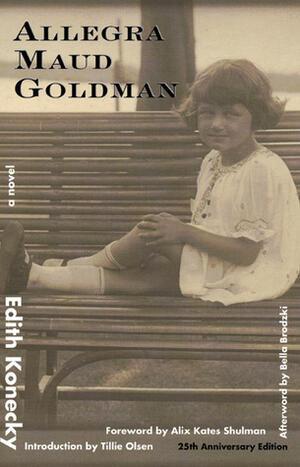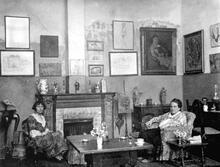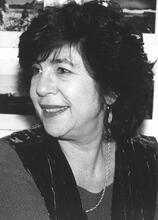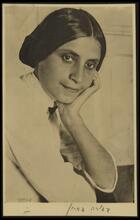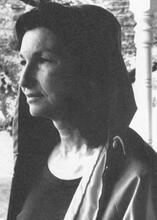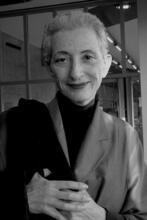Edith Konecky
Edith Konecky attended New York University from 1939 to 1941, married in 1944, and raised a family. She returned to writing and her college education at 37, studying at Columbia from 1959 to 1960. She began writing her first novel, Allegra Maud Goodman, a coming-of-age novel that chronicles the growth of a young female artist, in 1962, finally publishing it in 1976. She followed it with A Place at the Table in 1989, a short story collection in 2002, and A View to the North in 2004. Echoing her own painful childhood, the wives and daughters in Konecky’s fiction are cowed into stifling their thoughts and talents by wealthy, abusive men. It becomes the daughter’s task to question, criticize, and come into her own.
Overview and Novels
Edith Konecky, despite a small body of work, can lay claim to a large literary achievement with Allegra Maud Goldman (1976), a coming-of-age novel that chronicles the growth of a young female artist. In brilliantly comic, deceptively simple vignettes, Konecky depicts the world of a nouveau riche Jewish American family in the early part of the twentieth century. In her later novel, A Place at the Table (1989), Konecky explores similar territory through the eyes of an older, more experienced heroine, Rachel.
Konecky candidly acknowledges that her insight into the lives she depicts in her novels comes from personal experience. Like her heroines, Konecky was born in Brooklyn in the early 1920s (on August 1, 1922). Like Allegra, she has a brother, Martin Rubin, who is sixteen months older than she. And like both Allegra and Rachel, she is the daughter of a well-to-do dress manufacturer. For the father in the novels, the governing measure of worth—for himself or others—is money. Through this difficult, blunt, often cruel character, Konecky captures the crassness of a life lived in the pursuit of purely materialistic goals. Of her father, “the self-made man,” Allegra asks, “If he had to make himself, why couldn’t he have made himself nicer?”
Konecky suggests answers to this question in her second book, A Place at the Table. A child of immigrants escaping pogroms, an education that came more from the streets of the Lower East Side than the classroom, a shrewd reading of and subsequent internalization of American values provide a context for men like this father. He is the kind of man who scorns those who, unlike him, do not have a thriving business, a chauffeur, a cook, a wife who does not work, and a splendid home. He judges others with the statement, “If [they’re] so smart, why [aren’t they] rich?”
Not surprisingly, the materialistic emphasis in such a family relegates religious Jewish values to a minor place. Konecky, in fact, shows Jewish observance to be generally perfunctory and prominently gastronomic. She masterfully portrays the resentments and the meanness of this kind of life, the limited choices open to those “weaker souls”—the women and the sensitive children—not willing or not able to share these values, and the crushing family dynamics that leave scars and build strengths.
Biography and Later Life
Konecky said that Jewish custom made her a feminist before she had a word for it. She framed her work with that feminist perspective, examining ever-shifting Jewish female types and models of success in the twentieth century. First, there is the grandmother who escaped from Eastern Europe to become the baleboosteh, the successful American homemaker, offering love, superstition, and nourishment with her kreplakh. Then there is the mother, a once-strong woman who is tamed by social expectations to comply with her husband’s values and to channel her energies into card games and shopping.
Konecky, as well as her heroines, rejected this inheritance. But the biographical data of her life suggest that the rejection was gradual, keeping pace with the social movements of her day. Like Allegra, she began her writing career while still in high school, winning a short story contest for which she was paid a penny a word. The daughter of Harry and Elizabeth (Smith) Rubin (to whom she dedicated her first novel), she attended New York University from 1939 to 1941, enrolling when she was seventeen. In 1944, she married Murray L. Konecky. They had two children, Michael and Joshua, and lived a suburban life for close to twenty years. Konecky raised her children and wrote occasional short stories. When she was thirty-seven, she returned to college, this time taking classes at Columbia (1959–1960). The women’s movement had begun, and many standards for women were changing. She began writing Allegra Maud Goldman at the MacDowell Colony in 1962, winning fellowships to work there in succeeding years through 1996. In 1965, she was divorced. She won fellowships to Yaddo from 1969 to 1977, continuing to write and publish short stories.
Konecky dramatized some of the details of her transformations in her second novel, in which the heroine, Rachel, approaching sixty, reflects on the traumas and triumphs of her life: marriage, divorce, motherhood, grandmotherhood, her love of women, and her relationship to her work. Konecky won a Wurlitzer Foundation Fellowship in 1974 and was a New York Foundation of the Arts Fellow in 1992. Allegra Maud Goldman was reissued in 1990, fourteen years after its initial publication, with a new introduction by Tillie Olsen and an afterword by Bella Brodzki that pay tribute to the complexity and depth of Konecky’s work. Konecky published Past Sorrows and Coming Attractions in 2000, View to the North in 2004, and Love and Money in 2006. She published her last novel, Fiction and the Facts of Life, in 2011.
Edith Konecky died on March 28, 2019.
Selected Works by Edith Konecky
Novels
Allegra Maud Goldman (1976. Reprint, with an introduction by Tillie Olsen and
afterword by Bella Brodzki, 1990).
A Place at the Table (1989).
View to the North (2004).
Short Stories
“The Box.” Virgina Quarterly 46 (1970): 624–628.
“The Breakdown.” Story Magazine (1963).
“Charity.” Kenyon Review 25 (1963): 81–90.
“Death in New Rochelle.” Cosmopolitan (1973).
“The Hour.” Unpublished; “Lessons.” Virginia Quarterly 52 (1976): 79–90.
“Love and Friendship.” Cosmopolitan (1971).
“The Passion of Magda Wickwire.” Saturday Evening Post, July 31, 1965: 58–60.
“Past Sorrows and Coming Attractions.” In Women on Women II (June 1993).
“The Power.” Massachusetts Review 4 (1963): 651–670.
“Ralph.” Cosmopolitan (1970).
“The Sound of Comedy.” Esquire (January 1961): 53–56.
Poetry
Selected poems in Open Places, Fifteenth Anniversary Issue (1981), and Open Places, Humor in America Issue (1985).
Nonfiction
“The Breath of Life.” In The Writer’s Handbook (1991).
Brodzki, Bella. Afterword to Allegra Maud Goldman (1990).
D’Erasme, Stacey. Village Voice (September 19, 1989), 55.
Jacobs, Barbara. Booklist 73 (December 1, 1976): 526.
Levin, Martin. NYTimes Book Review, December 19, 1976, 22.
Olsen, Tillie. Introduction to Allegra Maud Goldman (1990).
Shulman, Alix Kates. “A Me Grows in Brooklyn.” Ms. (April 1977).
Williamson, Barbara Fisher. NYTimes Book Review, June 4, 1989, 22.

